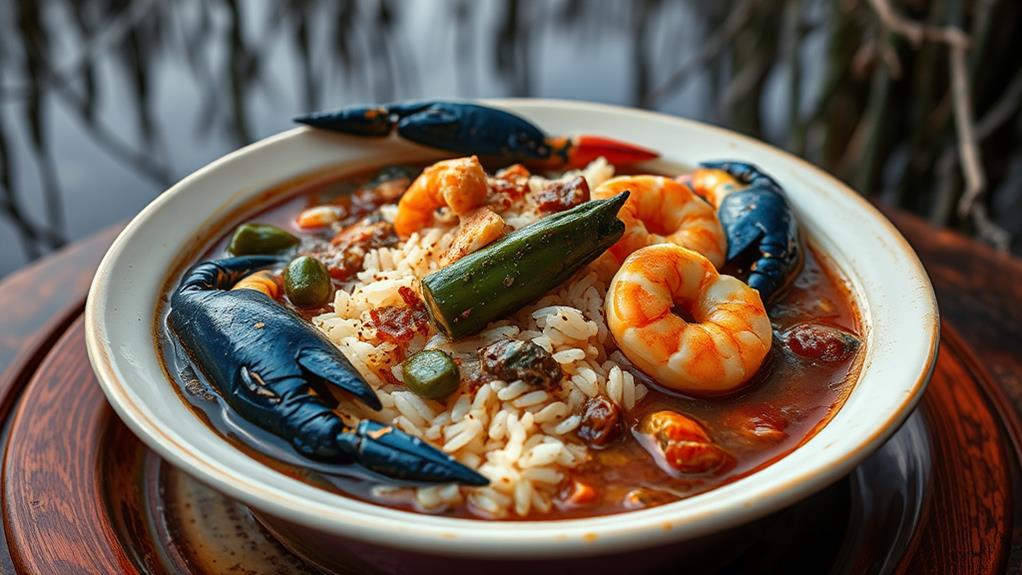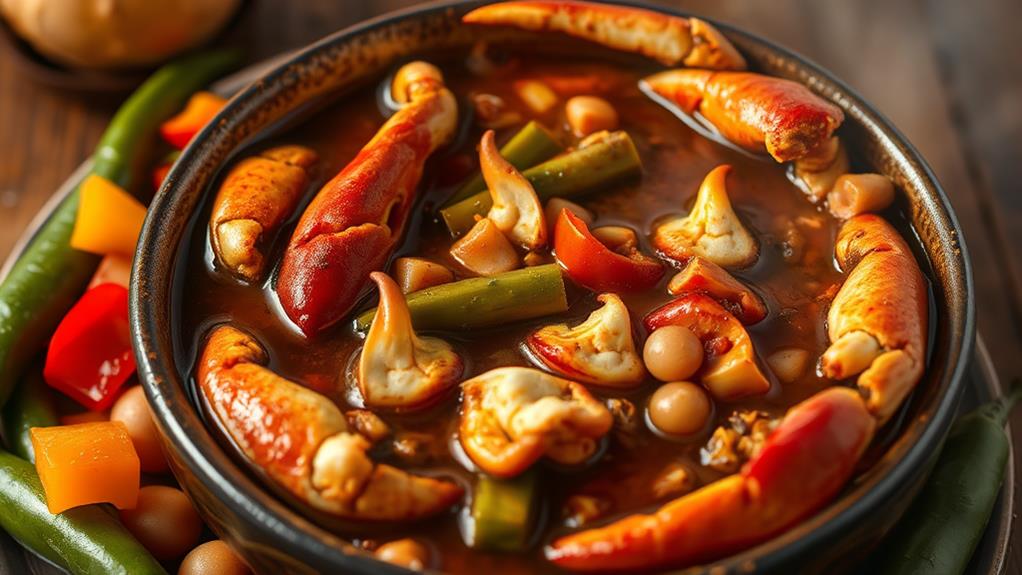What Are Gumbo Crabs
Gumbo crabs are small, flavorful crustaceans sourced from the Gulf of Mexico, particularly Louisiana's bayous. You'll find them as a key ingredient in traditional Southern cuisine, especially in gumbo recipes. These crabs are typically smaller and leaner than blue crabs, making them ideal for stews. They're harvested using sustainable practices and often sold pre-cleaned and frozen for convenience. Gumbo crabs offer a delicate, sweet flavor that enhances the rich, complex taste of gumbo. They're also nutritious, providing lean protein and essential minerals. Whether you're a seasoned chef or a curious home cook, understanding gumbo crabs can elevate your Southern cooking game. Exploring their culinary versatility opens up a world of authentic flavors.
This post may contain affiliate links. If you make a purchase through these links, I may earn a commission at no additional cost to you. Additionally, portions of this post may be generated using artificial intelligence (AI) technology. While we strive for accuracy, please be aware that AI-generated content may not always be perfect and should be fact-checked when necessary.
The Spatula Scoops
- Gumbo crabs are small, lean crabs sourced from the Gulf of Mexico, particularly Louisiana Bayous.
- They are wild-caught using sustainable practices and typically packaged in sets of 12 halves.
- These crabs are pre-cleaned and prepared, making them convenient for use in gumbos, stews, and other Southern dishes.
- Gumbo crabs have a delicate, sweet flavor and tender texture that enhances the authenticity of Gulf Coast recipes.
- They are a lean protein source, rich in nutrients like zinc and vitamin B12, with only about 80 calories per serving.
Origin of Gumbo Crabs

Gumbo Crabs, a seafood delicacy, hail from the rich waters of the Gulf of Mexico. Specifically, these whole blue crabs are sourced from the Louisiana Bayous, a region renowned for its diverse aquatic life. You'll find that Gumbo Crabs are wild-caught, guaranteeing you're getting an authentic taste of the Gulf's natural offerings.
The name "Gumbo Crabs" isn't just a catchy phrase; it's deeply rooted in Southern culinary tradition. These crustaceans are a staple ingredient in many Southern dishes, particularly in stews and gumbos, where they lend their distinct flavor and texture. When you're using Gumbo Crabs, you're tapping into generations of regional cooking expertise.
What sets Gumbo Crabs apart is their preparation. They're carefully processed with the backs removed and lungs taken out, making them ready for immediate culinary use. This preparation saves you time and effort in the kitchen. While they're harvested fresh, Gumbo Crabs are shipped frozen to preserve their quality during transit. This guarantees that when you're ready to cook, you're working with a product that's as close to freshly caught as possible.
Identifying Gumbo Crabs
You'll recognize Gumbo Crabs by their distinct physical characteristics and culinary preparation. These blue crabs are typically smaller and leaner than their traditional counterparts, making them ideal for incorporation into gumbos and stews. Unlike regular whole blue crabs, Gumbo Crabs arrive pre-prepared with their backs removed and lungs taken out, saving you time and effort in the kitchen.
Physical Characteristics
When it comes to identifying Gumbo Crabs, you'll notice they're distinct from traditional whole blue crabs. These specialty crustaceans are characterized by their smaller and skinnier shape, setting them apart from their larger counterparts. You'll find Gumbo Crabs packaged in a unique way, typically containing 12 halves that weigh around 16 ounces each. In total, you can expect to see about 3-5 crabs per pack, depending on their size.
One of the key physical characteristics of Gumbo Crabs is their preparation. The backs and lungs have been removed, making them ready for use in various dishes. This processing step enhances their usability, particularly in Southern cuisine like stews, soups, and, of course, gumbos. When you examine these crabs, you'll observe their wild-caught origin from the Gulf off Louisiana shores. This environment contributes to their mild, sweet flavor profile and tender, meat-rich texture. The crabs are packaged fresh and shipped frozen, ensuring you receive them in prime condition for your culinary creations.
Culinary Preparation Differences
For culinary enthusiasts, identifying Gumbo Crabs is essential to successfully preparing authentic Southern dishes. You'll notice that Gumbo Crabs are distinct from regular blue crabs due to their unique preparation. These crabs have their backs removed and lungs taken out, making them ready for use in various recipes.
When cooking with Gumbo Crabs, you'll find they're conveniently packaged in sets of 12 halves. This packaging allows for easy portion control and versatile use in traditional Southern recipes like gumbos, stews, and soups. Each 16 oz. package weighs about 3 pounds and contains 3-5 crabs, depending on their size.
The culinary preparation differences between Gumbo Crabs and regular blue crabs are significant. With Gumbo Crabs, you're saving time and effort in the kitchen as they're already cleaned and prepped. This allows you to focus on incorporating their tender meat into your dishes, enhancing the flavors of Gulf Coast cuisine. Remember, for the best results, use Gumbo Crabs fresh or frozen to preserve their quality and essence in your culinary creations.
Flavor Profile

Gumbo Crabs boast a delicate yet distinctive flavor profile that's become synonymous with Southern cuisine. You'll find these blue crabs offer a mild and sweet taste that's highly prized in Gulf Coast recipes. Their tender meat is rich and adds depth to various dishes, particularly gumbos and stews. When you're cooking with whole Gumbo Crabs, you're incorporating an authentic taste of the Louisiana Bayous into your meal.
Chefs value Gumbo Crabs for their versatility in flavor pairings. You can use them in multiple cooking methods, perfect for adding a unique touch to your culinary creations. Here's a breakdown of their flavor characteristics:
| Attribute | Description | Culinary Use |
|---|---|---|
| Taste | Mild, sweet | Enhances stews |
| Texture | Tender, rich | Adds depth |
| Origin | Louisiana Bayous | Authentic Southern flavor |
| Versatility | Adaptable | Various cooking methods |
When you're working with Gumbo Crabs, you're not just using an ingredient; you're embracing a Southern staple that enhances traditional flavors. Their unique taste allows you to create dishes that truly capture the essence of Gulf Coast cuisine, making them an essential component in any Southern chef's repertoire.
Nutritional Value
When you're looking for a nutritious seafood option, gumbo crabs are an excellent choice. You'll find these blue crabs are packed with lean protein and heart-healthy omega-3 fatty acids, while remaining low in calories. They're also a rich source of essential minerals like zinc and vitamin B12, making them a well-rounded addition to your diet.
Protein and Omega-3 Content
Nutrition enthusiasts and seafood lovers alike will appreciate the exceptional protein and omega-3 content of Gumbo Crabs. These crabs, which are whole blue crabs with the backs removed, are a powerhouse of nutrients. When you're adding them to stews, soups, and gumbos for flavor, you're also boosting your meal's nutritional value considerably.
Here's why Gumbo Crabs are a nutritional standout:
- High-quality protein: 20 grams per 3-ounce serving
- Omega-3 fatty acids: 1 gram per serving
- Low-calorie option: Only 80 calories per 3-ounce portion
You'll find that Gumbo Crabs, especially the prized Jumbo Lump meat, are an excellent source of lean protein. This protein is essential for muscle growth and repair. The omega-3 fatty acids in these crabs contribute to heart health and help reduce inflammation in your body. As you enjoy the meat inside, you're also getting important vitamins and minerals like vitamin B12, selenium, and zinc. These nutrients support your metabolic efficiency and immune function, making Gumbo Crabs a smart choice for your diet.
Mineral-Rich Crab Meat
Beyond their impressive protein and omega-3 content, Gumbo Crabs pack a punch with their mineral-rich meat. You'll find that these blue crabs are an excellent source of essential minerals, particularly selenium and copper. These minerals play significant roles in your body's antioxidant defense system and overall health. Selenium, for instance, supports thyroid function and helps protect your cells from damage, while copper aids in iron absorption and collagen formation.
But that's not all. The nutritional profile of Gumbo Crabs extends to other essential nutrients. You're getting a significant dose of vitamin B12 with every serving, which is necessary for nerve function and energy production. This makes Gumbo Crabs an ideal choice for maintaining your body's nervous system and keeping your energy levels up.
What's more, you're benefiting from all these nutrients without consuming excessive calories. A 3-ounce serving of blue crab meat contains only about 98 calories, making it a smart option if you're watching your calorie intake. You're getting a nutrient-dense food that supports your health goals without compromising on taste or satisfaction.
Low-Calorie Seafood Option
Calorie consciousness meets culinary delight in Gumbo Crabs. If you're looking for a low-calorie seafood option that doesn't skimp on flavor, these crustaceans are an excellent choice. With just 70 calories per 3-ounce serving of cooked blue crab meat, you can indulge without derailing your diet.
Gumbo crabs aren't just low in calories; they're also packed with nutritional benefits:
- High protein content (14-15 grams per serving)
- Low fat (less than 1 gram per serving)
- Rich in essential nutrients like vitamin B12, selenium, and zinc
You'll appreciate that gumbo crabs are versatile enough to fit into various dietary plans, including low-carb and ketogenic diets. Their minimal carbohydrate content makes them an ideal protein source for those watching their carb intake.
When incorporating gumbo crabs into your meals, you're not only satisfying your taste buds but also supporting your overall health. The high protein content helps maintain muscle mass, while the low-fat profile promotes heart health and weight management. Additionally, the essential nutrients contribute to a strong immune system and general well-being. Whether you're counting calories or simply seeking a nutritious seafood option, gumbo crabs deliver on both fronts.
Preparing Gumbo Crabs

Preparing Gumbo Crabs is a straightforward process, thanks to their convenient pre-cleaning. You'll find these wild-caught blue crabs with their backs removed and lungs taken out, saving you time and effort in the kitchen. Typically, you'll receive three 1-pound packs, each containing about 3-5 crabs, depending on their size.
When it comes to cooking Gumbo Crabs, you have several options at your disposal. You can use the stovetop for quick sautéing or slow simmering in stews and soups. Baking is another excellent method, allowing you to infuse the crabs with various flavors. For a traditional approach, try boiling them with your favorite seasonings. If you're looking to add a unique twist, consider marinating the crabs before cooking.
The versatility of Gumbo Crabs makes them perfect for enhancing Gulf Coast cuisine. Their tender meat and rich flavor complement other ingredients beautifully, adding depth to your dishes. Whether you're making a classic gumbo or experimenting with new recipes, these pre-prepared crabs will elevate your culinary creations with minimal fuss.
Cooking Techniques
When it comes to cooking Gumbo Crabs, you'll find a variety of techniques at your disposal. These versatile crustaceans can be prepared using stovetop cooking, baking, sautéing, boiling, or marinating methods. This flexibility allows you to incorporate them into various dishes, from stews and soups to gumbos.
To make the most of your Gumbo Crabs, consider these key points:
- Add the crabs during the final stages of cooking stews, soups, or gumbos for best flavor integration.
- Remove the backs and lungs of the crabs before cooking to make them easier to use in recipes.
- Cook Gumbo Crabs from frozen to preserve their quality and enhance the richness of the blue crab meat.
Due to their smaller size compared to traditional whole blue crabs, Gumbo Crabs add unique textures and flavors without overwhelming your dishes. This makes them an excellent choice for creating complex flavor profiles in your culinary creations. Remember, the key to success with Gumbo Crabs lies in understanding their characteristics and adapting your cooking techniques accordingly.
Gumbo Recipe Variations

Building on the versatility of Gumbo Crabs, let's explore the exciting world of gumbo recipe variations. You'll find that whole blue crabs can be incorporated into various gumbo styles, each offering a unique culinary experience. Whether you're preparing a seafood gumbo, a chicken and sausage version, or even a vegetarian option, gumbo crabs can add depth and richness to your dish.
When crafting your gumbo, you'll want to start with a traditional roux base. Then, you can add your gumbo crabs, which have been prepared by removing their backs and lungs for easy use. To enhance the crab's flavor, you'll typically use a combination of seasonings like cayenne pepper, paprika, and thyme. These spices complement the crab meat perfectly, creating a harmonious blend of flavors in your stew-like soup.
Seasonal Availability
Throughout the year, the availability of Gumbo Crabs fluctuates due to seasonal factors. You'll find that these crustaceans, typically wild-caught in Louisiana Bayous, are most abundant during the warmer months, from late spring to early fall. This peak season aligns with the ideal conditions for blue crabs, the primary source of Gumbo Crabs.
When planning your gumbo, keep in mind that seasonal variations can impact pricing and supply. Here are three key points to take into account:
- Local fishing regulations and water conditions affect availability
- Demand increases during holidays and events like Mardi Gras
- Frozen options provide year-round access
You'll notice that seafood suppliers often anticipate these seasonal trends, adjusting their stock levels to meet customer demand. During off-peak seasons, you might find it challenging to source fresh Gumbo Crabs. However, many suppliers offer frozen alternatives, ensuring you can still enjoy this Southern delicacy year-round. When shopping for Gumbo Crabs, regard the season and be prepared for potential price fluctuations. By understanding these seasonal patterns, you'll be better equipped to plan your gumbo-making adventures and secure the best quality crabs for your recipe.
Sustainable Harvesting Practices

Sustainable harvesting practices play a key role in ensuring the long-term availability of Gumbo Crabs. You'll find that these blue crabs, sourced from Louisiana Bayous, are wild-caught using responsible fishing techniques. These methods prioritize minimizing bycatch and protecting crab populations, which is essential for maintaining the ecological balance in coastal habitats.
When you enjoy Gumbo Crabs, you're supporting local fisheries and sustainable seafood practices. The regulations in place for crab fishing include quotas and seasonal closures, which help prevent overfishing and protect crabs during breeding periods. This commitment to sustainability not only benefits the environment but also enhances the quality and flavor of the crabs you're consuming.
Frequently Asked Questions
Can You Eat Gumbo Crabs?
Yes, you can eat Gumbo Crabs. They're wild-caught blue crabs known for their mild, sweet flavor and tender meat. These crabs come prepped with backs removed and lungs taken out, making them perfect for various dishes. You'll get 12 halves per pack, ideal for stews, soups, and gumbos. You can cook them using different methods like stovetop, baking, or boiling. They're shipped frozen to maintain quality and freshness, ensuring a safe and delicious seafood experience.
What Are Gumbo Crabs Used For?
Gumbo crabs are primarily used to enhance the flavor of gumbo, a popular Southern dish. You'll find them adding depth and richness to various soups and stews, especially in Gulf Coast cuisine. They're versatile ingredients that you can bake, boil, sauté, or marinate for different recipes. With their backs removed and lungs taken out, they're easy to incorporate into your cooking. Whether you're making traditional gumbo or exploring other seafood dishes, these crabs are a convenient and flavorful addition to your culinary repertoire.
Do You Clean Gumbo Crabs?
While Gumbo Crabs come partially prepared, you'll still need to clean them before cooking. You'll want to rinse them thoroughly under cold water, removing any remaining debris or organs. It's important to check for and discard any dead crabs, which you can identify by a lack of movement or unpleasant odor. Although they're easier to work with than completely raw crabs, you'll need to take these final steps to guarantee they're ready for your gumbo recipe.
Can You Put Soft Shell Crab in Gumbo?
Yes, you can definitely put soft shell crabs in gumbo. They're a fantastic addition that brings a unique texture and flavor to the dish. You'll want to add them towards the end of cooking to keep them tender. Their mild, sweet taste complements the gumbo's spices beautifully. Unlike hard shell crabs, you don't need to remove the shells, making them easier to eat. Using soft shell crabs can elevate your gumbo, adding a touch of Southern delicacy to this traditional dish.





